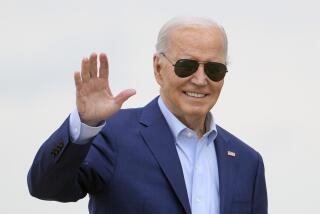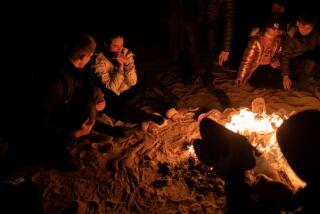U.S. Sending 25,000 Troops to Persian Gulf
In a major mobilization for possible war with Iraq, the Pentagon this week ordered about 25,000 military personnel to the Persian Gulf and instructed the Navy to prepare two aircraft carriers for rapid deployment to the region, Defense Department officials said Friday.
The deployments of air, sea and land forces were described by Pentagon officials as the largest to date as the United States continues assembling the pieces for an invasion of Iraq that many believe could come in February.
The movements are expected to unfold over several weeks, starting within days of the arrival of the New Year. They involve Air Force fighter and bomber wings, Army infantry units, air mobile units and a Navy hospital ship. Units are to be drawn from bases across the nation.
“The potential conflict in Iraq is about to become very real to Americans all across the country,” said a senior military official who spoke on condition of anonymity.
President Bush approved the plan last week in a White House session with Defense Secretary Donald H. Rumsfeld and Army Gen. Tommy Franks, who would lead U.S. forces in any invasion of Iraq. But the orders weren’t sent out until after Christmas.
When the movements are completed, the Pentagon will have positioned about half the 50,000 troops officials had previously indicated they would be moving to the region. They will join an estimated 57,000 troops already in position.
Officials indicated that a second deployment will come soon, although they refused to say when.
“We’re going to continue our steady buildup,” another senior military official said.
He and others at the Pentagon confirmed that there are two objectives. One is to ratchet up pressure on Iraq to comply with U.N. resolutions to disarm. The other is to have enough military firepower in the region to respond quickly -- within weeks, if not days -- if invasion orders come from the White House.
“We’re going to help the diplomatic process as much as possible,” one official said. Another said: “This is saber-rattling. Iraq is going to have the saber at their door pretty soon.”
In Crawford, Texas, near where Bush is spending 10 days at his ranch, Scott McClellan, the deputy White House press secretary, refused to comment, saying, “We don’t discuss military matters, including deployments.”
The Pentagon has been moving forces and equipment into the Gulf region since early this year.
Until now, the movement has been primarily of equipment and materiel, not of large numbers of troops. Officials said the new deployments mark the start of a more visible phase of the military buildup.
“We have reached that time where the next big thing we’re doing is high optics,” or highly visible, a senior U.S. official said. “If the president is going to decide to go to war early next year, a lot of very visible, real world things have to happen.”
Starting Thursday, enough warplanes and fighter pilots to launch a comprehensive air campaign will begin moving to air bases in Qatar, Kuwait, Bahrain and other nations surrounding Iraq, officials said.
First to go will be the 1st Fighter Wing and its fleet of 54 F-15C fighter jets, based at Langley Air Force Base in Virginia; the 4th Fighter Wing and its 92 F-15E Strike Eagles from Seymour Johnson Air Force Base in North Carolina; and the 28th Bomb Wing, flying B-1B Lancers out of Ellsworth Air Force Base in South Dakota, said Maj. Roger Lawson, a spokesman for Air Combat Command, which oversees all combat Air Force units based in the U.S.
Also deploying will be the 57th Wing, based at Nellis Air Force Base in Nevada, Lawson said. It will be flying HH-60 helicopters and the Predator aerial unmanned vehicle. The 347th Rescue Wing at Moody Air Force Base in Georgia has also been ordered to deploy its combat search-and-rescue assets, including its fleet of HC-130 airplanes, Lawson said.
The Army has been ordered to deploy light infantry and air mobile units to the Iraq region, a senior military official said. Army officials would not comment on which of their units have received deployment orders.
The Army troops most likely to be deployed first from the U.S. in the event of war are the 4th Infantry Division, the 1st Cavalry Division, the 82nd Airborne Division and the 101st Air Assault Division. An Army division also could move from U.S. bases in Germany.
“Things are getting put in place,” said Jim Wilkinson, spokesman for Central Command, which oversees U.S. forces in the Middle East and Southwest Asia. “The president has made no decision, and we don’t comment on specific mobilization orders. However, assets are moving to the region should the president decide to use them for any contingency.”
The Navy was ordered to prepare two aircraft carriers -- one from the East Coast and one from the West -- for quick deployment to the Gulf next month. Although it’s not certain that the carriers would be sent, the vessels are to be ready to ship out within 96 hours.
The Navy already has two carriers in the region: the Constellation in the Gulf and the Harry S Truman in the Mediterranean Sea.
The United States has not had more than two carriers in position around Iraq, except for short periods during rotations, since the end of the 1991 Persian Gulf War, officials said.
Officials said two nuclear-powered carriers that have left the Gulf will probably be readied for redeployment. One, the George Washington, recently returned to its home port in Norfolk, Va. The other, the Abraham Lincoln, has not been selected but is expected to be. It was stopped in Perth, Australia, on its way back to its home port at Everett, Wash.
Each carrier has about 75 warplanes and 5,000 sailors, and is accompanied by its own escort of destroyers, cruisers and submarines. The United States launched thousands of sorties from six carriers stationed in the Middle East during the Gulf War.
The only immediate deployment for the Navy, however, involves one of its vast hospital ships, the Comfort. The 946-foot vessel, berthed in Baltimore, is equipped to operate as a 1,000-bed floating hospital with two operating rooms.
“The primary mission is to provide flexible medical response to support wartime operations,” said Marge Holtz, director of public affairs for the U.S. Navy’s Military Sealift Command. “She is equipped to care for the victims of all types of medical trauma, including the effects of a chemical or biological attack.”
Holtz said the Comfort won’t set sail until late next week or the beginning of the following week at the earliest, to give the 225 active-duty Navy personnel and 61 civilian mariners who operate the ship time to load “enormous” amounts of medical supplies onto it.
Once it embarks, it will take three weeks to arrive at its destination, she said. Medical personnel will fly in to a location near the Comfort’s destination and be helicoptered to the ship once it arrives, she said.
It was not clear whether Marines were involved in the latest deployment orders. More than 2,200 Marines and sailors who are part of the 15th Marine Expeditionary Unit are already set to leave Camp Pendleton as part of the Tarawa Amphibious Ready Group in early January for the Gulf, officials at that sprawling Southern California base said. Those orders were issued weeks ago.
No decision has been made on whether the Marines will go by ship or transport planes, officials said.
Marines from the 15th Marine Expeditionary Unit were the first conventional U.S. troops into Afghanistan last year.
*
Times staff writers Tony Perry in San Diego and James Gerstenzang in Crawford contributed to this report.
More to Read
Start your day right
Sign up for Essential California for news, features and recommendations from the L.A. Times and beyond in your inbox six days a week.
You may occasionally receive promotional content from the Los Angeles Times.






